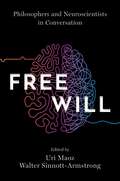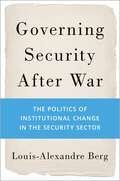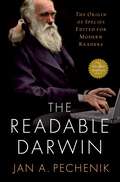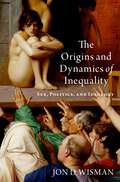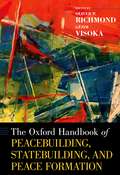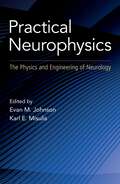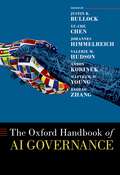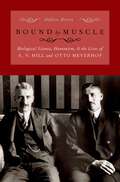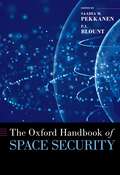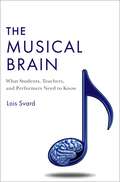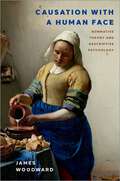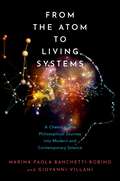- Table View
- List View
Free Will: Philosophers and Neuroscientists in Conversation
What is free will? Can it exist in a determined universe? How can we determine who, if anyone, possesses it? Philosophers have debated the extent of human free will for millennia. In recent decades neuroscientists have joined the fray with questions of their own. Which neural mechanisms could enable conscious control of action? What are intentional actions? Do contemporary developments in neuroscience rule out free will or, instead, illuminate how it works? Over the past few years, neuroscientists and philosophers have increasingly come to understand that both fields can make substantive contributions to the free-will debate, so working together is the best path forward to understanding whether, when, and how our choices might be free This book contains thirty bidirectional exchanges between neuroscientists and philosophers that focus on the most critical questions in the neurophilosophy of free will. It mimics a lively, interdisciplinary conference, where experts answer questions and follow-up questions from the other field, helping each discipline to understand how the other thinks and works. Each chapter is concise and accessible to non-experts-free from disciplinary jargon and highly technical details-but also employs thorough and up-to-date research from experts in the field. The resulting collection should be useful to anyone who wants to get up to speed on the most fundamental issues in the rising field of the neurophilosophy of free will. It will interest experts from philosophy or neuroscience who want to learn about the other discipline, students in courses on a host of related topics, and lay readers who are fascinated by these profound issues.
Free Will: Philosophers and Neuroscientists in Conversation
by Uri Maoz and Walter Sinnott- ArmstrongWhat is free will? Can it exist in a determined universe? How can we determine who, if anyone, possesses it? Philosophers have debated the extent of human free will for millennia. In recent decades neuroscientists have joined the fray with questions of their own. Which neural mechanisms could enable conscious control of action? What are intentional actions? Do contemporary developments in neuroscience rule out free will or, instead, illuminate how it works? Over the past few years, neuroscientists and philosophers have increasingly come to understand that both fields can make substantive contributions to the free-will debate, so working together is the best path forward to understanding whether, when, and how our choices might be free This book contains thirty bidirectional exchanges between neuroscientists and philosophers that focus on the most critical questions in the neurophilosophy of free will. It mimics a lively, interdisciplinary conference, where experts answer questions and follow-up questions from the other field, helping each discipline to understand how the other thinks and works. Each chapter is concise and accessible to non-experts-free from disciplinary jargon and highly technical details-but also employs thorough and up-to-date research from experts in the field. The resulting collection should be useful to anyone who wants to get up to speed on the most fundamental issues in the rising field of the neurophilosophy of free will. It will interest experts from philosophy or neuroscience who want to learn about the other discipline, students in courses on a host of related topics, and lay readers who are fascinated by these profound issues.
Governing Security After War: The Politics of Institutional Change in the Security Sector
by Louis-Alexandre BergSecurity assistance has become the largest component of international peacebuilding and stabilization efforts, and a primary tool for responding to civil war and insurgency. Donors and peacekeepers not only train and equip military and police forces, they also seek to overhaul their structure, management, and oversight. Yet, we know little about why these efforts succeed or fail. Efforts to restructure security forces in Iraq, Libya, South Sudan, Timor-Leste, and the Democratic Republic of Congo ended amidst factional fighting. Similar efforts in Liberia, Sierra Leone, El Salvador, Mozambique, and Bosnia and Herzegovina helped to transform security forces and underpin peace. What accounts for the mixed outcomes of efforts to restructure security forces after civil war? What is the role of external involvement on these outcomes? In Governing Security After War, Louis-Alexandre Berg examines the political dimensions of security governance through systematic, cross-country comparison. Berg argues that the extent to which state policymakers adopt changes to the management and oversight of security forces depends on internal political dynamics, specifically the degree to which leaders need to consolidate power. The different political strategies leaders pursue, in turn, affect opportunities for external actors to influence institutional changes through means such as conditions on aid, norm diffusion, or day-to-day participation in decision-making. Drawing on an original dataset of security governance and field research in Liberia, Bosnia and Herzegovina, and Timor-Leste, as well as mini-case studies of Iraq, Afghanistan, South Sudan, and Somalia, Berg draws out novel implications that help explain the recurrence of civil war and the impact of foreign aid on peacebuilding. Moreover, Berg provides practical recommendations for navigating the political challenges of institutional change in conflict-affected countries. Ultimately, Governing Security After War seeks to explain the success and failure of international assistance in war-torn countries and sheds light on the politics of peacebuilding.
Governing Security After War: The Politics of Institutional Change in the Security Sector
by Louis-Alexandre BergSecurity assistance has become the largest component of international peacebuilding and stabilization efforts, and a primary tool for responding to civil war and insurgency. Donors and peacekeepers not only train and equip military and police forces, they also seek to overhaul their structure, management, and oversight. Yet, we know little about why these efforts succeed or fail. Efforts to restructure security forces in Iraq, Libya, South Sudan, Timor-Leste, and the Democratic Republic of Congo ended amidst factional fighting. Similar efforts in Liberia, Sierra Leone, El Salvador, Mozambique, and Bosnia and Herzegovina helped to transform security forces and underpin peace. What accounts for the mixed outcomes of efforts to restructure security forces after civil war? What is the role of external involvement on these outcomes? In Governing Security After War, Louis-Alexandre Berg examines the political dimensions of security governance through systematic, cross-country comparison. Berg argues that the extent to which state policymakers adopt changes to the management and oversight of security forces depends on internal political dynamics, specifically the degree to which leaders need to consolidate power. The different political strategies leaders pursue, in turn, affect opportunities for external actors to influence institutional changes through means such as conditions on aid, norm diffusion, or day-to-day participation in decision-making. Drawing on an original dataset of security governance and field research in Liberia, Bosnia and Herzegovina, and Timor-Leste, as well as mini-case studies of Iraq, Afghanistan, South Sudan, and Somalia, Berg draws out novel implications that help explain the recurrence of civil war and the impact of foreign aid on peacebuilding. Moreover, Berg provides practical recommendations for navigating the political challenges of institutional change in conflict-affected countries. Ultimately, Governing Security After War seeks to explain the success and failure of international assistance in war-torn countries and sheds light on the politics of peacebuilding.
The Readable Darwin: The Origin of Species Edited for Modern Readers
by Jan A. PechenikDarwin's The Origin of Species is one of the most influential books ever written. It is essential reading for anyone interested in biology, evolution, the natural world, or the history of scientific thought. However, the book can be difficult to follow. The sentences and paragraphs are lengthy, and Darwin often references people and ideas unfamiliar to contemporary readers. The Readable Darwin translates the sixth and final edition of Darwin's The Origin of Species (1872) into clear, engaging prose. Whereas the first edition of The Readable Darwin includes the first eight chapters of Darwin's book, this new edition presents all fifteen chapters of The Origin of Species and features over 100 illustrations. The Readable Darwin begins by discussing artificial selection, demonstrating that selection for new traits can indeed be made to occur, even within our lifetimes. It then presents evidence for natural selection derived from developmental traits and the geological record. Throughout, Pechenik painstakingly revises Darwin's prose. He breaks up long paragraphs, shortens and reorganizes sentences, and replaces weak verbs with strong ones. Footnotes clarify concepts, define terms, and identify the many historical figures Darwin mentions. The Origin of Species is a foundational work of scholarship in the biological sciences. It documents the remarkable diversity of life on earth and is a wonderful example of honest and logical scientific thinking. The Readable Darwin brings this groundbreaking book to life for readers of all backgrounds while remaining true to the original text.
The Readable Darwin: The Origin of Species Edited for Modern Readers
by Jan A. PechenikDarwin's The Origin of Species is one of the most influential books ever written. It is essential reading for anyone interested in biology, evolution, the natural world, or the history of scientific thought. However, the book can be difficult to follow. The sentences and paragraphs are lengthy, and Darwin often references people and ideas unfamiliar to contemporary readers. The Readable Darwin translates the sixth and final edition of Darwin's The Origin of Species (1872) into clear, engaging prose. Whereas the first edition of The Readable Darwin includes the first eight chapters of Darwin's book, this new edition presents all fifteen chapters of The Origin of Species and features over 100 illustrations. The Readable Darwin begins by discussing artificial selection, demonstrating that selection for new traits can indeed be made to occur, even within our lifetimes. It then presents evidence for natural selection derived from developmental traits and the geological record. Throughout, Pechenik painstakingly revises Darwin's prose. He breaks up long paragraphs, shortens and reorganizes sentences, and replaces weak verbs with strong ones. Footnotes clarify concepts, define terms, and identify the many historical figures Darwin mentions. The Origin of Species is a foundational work of scholarship in the biological sciences. It documents the remarkable diversity of life on earth and is a wonderful example of honest and logical scientific thinking. The Readable Darwin brings this groundbreaking book to life for readers of all backgrounds while remaining true to the original text.
The Origins and Dynamics of Inequality: Sex, Politics, and Ideology
by Jon D. WismanArgues that the struggle over income, wealth, status and privilege-inequality-has been the principal, defining issue in human history and provides a novel framework for understanding inequality today Whereas President Barack Obama declared inequality as the defining issue of our time, in The Origins and Dynamics of Inequality, Jon D. Wisman claims more: it is the defining issue of all human history. The struggle over inequality has been the underlying force driving human history's unfolding. Drawing on the dynamics of inequality, Wisman re-interprets economic history and society. Beyond according inequality the central role in history, this book is novel in two other respects: First, transcending the general failure of social scientists and historians to anchor their work in explicit theories of human behaviour, this book grounds the origins and dynamics of inequality in evolutionary psychology, or more specifically, Darwin's theory of sexual selection. Second, this book accords central importance to ideology in legitimating inequality, a role typically inadequately addressed by social scientists and historians. Because of the central role of inequality in history, inequality's explosion over the past forty years has not been an anomaly. It is a return to the political dynamics by which elites have, since the rise of the state, taken practically everything for themselves, leaving all others with little more than the means with which to survive. Due to elites' persuasive ideology, even after workers in advanced capitalist countries gained the franchise to become the overwhelming majority of voters, inequality continued to increase. Sweeping and provocative, Jon D. Wisman presents a fresh perspective on why economic inequality exists and how its dynamics have shaped human history.
The Origins and Dynamics of Inequality: Sex, Politics, and Ideology
by Jon D. WismanArgues that the struggle over income, wealth, status and privilege-inequality-has been the principal, defining issue in human history and provides a novel framework for understanding inequality today Whereas President Barack Obama declared inequality as the defining issue of our time, in The Origins and Dynamics of Inequality, Jon D. Wisman claims more: it is the defining issue of all human history. The struggle over inequality has been the underlying force driving human history's unfolding. Drawing on the dynamics of inequality, Wisman re-interprets economic history and society. Beyond according inequality the central role in history, this book is novel in two other respects: First, transcending the general failure of social scientists and historians to anchor their work in explicit theories of human behaviour, this book grounds the origins and dynamics of inequality in evolutionary psychology, or more specifically, Darwin's theory of sexual selection. Second, this book accords central importance to ideology in legitimating inequality, a role typically inadequately addressed by social scientists and historians. Because of the central role of inequality in history, inequality's explosion over the past forty years has not been an anomaly. It is a return to the political dynamics by which elites have, since the rise of the state, taken practically everything for themselves, leaving all others with little more than the means with which to survive. Due to elites' persuasive ideology, even after workers in advanced capitalist countries gained the franchise to become the overwhelming majority of voters, inequality continued to increase. Sweeping and provocative, Jon D. Wisman presents a fresh perspective on why economic inequality exists and how its dynamics have shaped human history.
The Oxford Handbook of Peacebuilding, Statebuilding, and Peace Formation (Oxford Handbooks)
by Oliver P. Richmond and Gëzim VisokaIn addition to being a major area of research within International Relations, peacebuilding and statebuilding is a major policy area within the UN and other international and regional organizations. It is also a concern of international financial institutions, including the World Bank, and a significant factor in the foreign and security policies of many established and emerging democracies. Peacebuilding and statebuilding are among the main approaches for preventing, managing, and mitigating global insecurities; dealing with the humanitarian consequences of civil wars; and expanding democracy and neoliberal economic regimes. Peace formation is a relatively new concept, addressing how local actors work in parallel to international and national projects, and helps shape the legitimacy of peace processes and state reform. The Oxford Handbook of Peacebuilding, Statebuilding, and Peace Formation serves as an essential guide to this vast intellectual and policy landscape. It offers a systematic overview of conceptual foundations, political implications, and tensions at the global, regional, and local levels, as well as key policies, practices, examples, and discourses underlining all segments of peacebuilding and statebuilding praxis. Approaching peacebuilding from disciplinary perspectives across the social sciences, the Handbook is organized around four major thematic sections. Section one explores how peacebuilding, statebuilding, and peace formation is conceived by different disciplines and IR approaches, thus offering an overview of the conceptual bedrock of major theories and approaches. Section two situates these approaches among other major global issues, including globalization, civil society, terrorism, and technology to illustrate their global, regional, and local resonance. Section three looks at key themes in the field, including peace agreements, democratization, security reform, human rights, environment, and culture. Finally, section four looks at key features of everyday and civil society peace formation processes, both in theory and in practice.
Practical Neurophysics: The Physics and Engineering of Neurology
Practical Neurophysics: The Physics and Engineering of Neurology explores and explains the physical foundations of neurology with a principal focus on the technologies that we use for diagnosis and management. The physics of biologic systems is also discussed, in the context of interfacing with our technologies and the mechanisms behind abnormalities. With sections on ultrasound, advanced laboratory tests, and neurotherapeutics, this is a unique book that focuses on the science and engineering rather than on disease processes. This book is intended to give the reader an appreciation of the mechanisms behind our technology and how humans and machines interface. The spectrum of presented information ranges from basic atomic physics to electronics to mechanisms of abnormalities on MRI and EEG. With this book, the reader should have a better understanding of the mechanisms of the technologies we use as well as an understanding of how normal and pathological functioning produces findings we can record.
Practical Neurophysics: The Physics and Engineering of Neurology
by Evan M. Johnson and Karl E. MisulisPractical Neurophysics: The Physics and Engineering of Neurology explores and explains the physical foundations of neurology with a principal focus on the technologies that we use for diagnosis and management. The physics of biologic systems is also discussed, in the context of interfacing with our technologies and the mechanisms behind abnormalities. With sections on ultrasound, advanced laboratory tests, and neurotherapeutics, this is a unique book that focuses on the science and engineering rather than on disease processes. This book is intended to give the reader an appreciation of the mechanisms behind our technology and how humans and machines interface. The spectrum of presented information ranges from basic atomic physics to electronics to mechanisms of abnormalities on MRI and EEG. With this book, the reader should have a better understanding of the mechanisms of the technologies we use as well as an understanding of how normal and pathological functioning produces findings we can record.
The Oxford Handbook of AI Governance (Oxford Handbooks)
As the capabilities of Artificial Intelligence (AI) have increased over recent years, so have the challenges of how to govern its usage. Consequently, prominent stakeholders across academia, government, industry, and civil society have called for states to devise and deploy principles, innovative policies, and best practices to regulate and oversee these increasingly powerful AI tools. Developing a robust AI governance system requires extensive collective efforts throughout the world. It also raises old questions of politics, democracy, and administration, but with the new challenges posed by AI's growing influence on markets, governing structures, international relations, healthcare, science, and political activism. The Oxford Handbook of AI Governance delineates the scope of these issues and addresses the key questions of AI governance. Across forty-nine chapters, organized in nine major sections, the Handbook covers the theoretical and ethical foundations of AI governance, different frameworks for developing a governance structure for AI, practical perspectives on AI governance in different policy domains, economic analyses of AI governance, and concrete lessons about the impact of AI governance domestically and internationally. Chapter authors come from a wide set of disciplines, areas of study, and cultural backgrounds, providing a global perspective on AI governance.
The Oxford Handbook of AI Governance (Oxford Handbooks)
by Justin B. Bullock, Yu-Che Chen, Johannes Himmelreich, Valerie M. Hudson, Anton Korinek, Matthew M. Young and Baobao ZhangAs the capabilities of Artificial Intelligence (AI) have increased over recent years, so have the challenges of how to govern its usage. Consequently, prominent stakeholders across academia, government, industry, and civil society have called for states to devise and deploy principles, innovative policies, and best practices to regulate and oversee these increasingly powerful AI tools. Developing a robust AI governance system requires extensive collective efforts throughout the world. It also raises old questions of politics, democracy, and administration, but with the new challenges posed by AI's growing influence on markets, governing structures, international relations, healthcare, science, and political activism. The Oxford Handbook of AI Governance delineates the scope of these issues and addresses the key questions of AI governance. Across forty-nine chapters, organized in nine major sections, the Handbook covers the theoretical and ethical foundations of AI governance, different frameworks for developing a governance structure for AI, practical perspectives on AI governance in different policy domains, economic analyses of AI governance, and concrete lessons about the impact of AI governance domestically and internationally. Chapter authors come from a wide set of disciplines, areas of study, and cultural backgrounds, providing a global perspective on AI governance.
Bound by Muscle: Biological Science, Humanism, and the Lives of A. V. Hill and Otto Meyerhof
by Andrew BrownIn Bound by Muscle, Andrew Brown details the lives and achievements of two physiologists, Archibald Vivian Hill (1886-1977) and Otto Fritz Meyerhof (1884-1951). Hill and Meyerhof shared the 1922 Nobel Prize in Physiology or Medicine for discoveries related to metabolic changes underlying muscle activity. Bound by Muscle describes how Hill and Meyerhof's lives and careers intersected and diverged and how their work changed the course of biological science. Bound by Muscle is organized chronologically. The first four chapters consider Hill and Meyerhof's childhoods and early careers; subsequent chapters address the Nobel Prize nomination and award and how their lives were affected by the World Wars. Bound by Muscle details Hill and Meyerhof's scientific breakthroughs and professional accomplishments. The book also examines the historical context that shaped their work and how the two men differed. Hill embodied the pragmatic style of British science. He became an outspoken critic of fascism as well as an effective humanitarian. As a senior scientist, he played major roles in preparing Great Britain for World War II. In contrast, Meyerhof was shy and philosophical. A non-observant Jew, he was reluctant to leave his superb laboratory in Heidelberg as the Nazi threat became apparent. His dramatic eventual escape is described in detail for the first time. Throughout, Bound by Muscle reflects on how individual differences and historical events have shaped the trajectory of science.
Bound by Muscle: Biological Science, Humanism, and the Lives of A. V. Hill and Otto Meyerhof
by Andrew BrownIn Bound by Muscle, Andrew Brown details the lives and achievements of two physiologists, Archibald Vivian Hill (1886-1977) and Otto Fritz Meyerhof (1884-1951). Hill and Meyerhof shared the 1922 Nobel Prize in Physiology or Medicine for discoveries related to metabolic changes underlying muscle activity. Bound by Muscle describes how Hill and Meyerhof's lives and careers intersected and diverged and how their work changed the course of biological science. Bound by Muscle is organized chronologically. The first four chapters consider Hill and Meyerhof's childhoods and early careers; subsequent chapters address the Nobel Prize nomination and award and how their lives were affected by the World Wars. Bound by Muscle details Hill and Meyerhof's scientific breakthroughs and professional accomplishments. The book also examines the historical context that shaped their work and how the two men differed. Hill embodied the pragmatic style of British science. He became an outspoken critic of fascism as well as an effective humanitarian. As a senior scientist, he played major roles in preparing Great Britain for World War II. In contrast, Meyerhof was shy and philosophical. A non-observant Jew, he was reluctant to leave his superb laboratory in Heidelberg as the Nazi threat became apparent. His dramatic eventual escape is described in detail for the first time. Throughout, Bound by Muscle reflects on how individual differences and historical events have shaped the trajectory of science.
The Oxford Handbook of Space Security (Oxford Handbooks)
by Saadia M. PekkanenSpace security is a complex assemblage of societal risks and benefits that result from space-based capabilities and is currently in a period of transformation as innovative processes are rapidly changing the underlying assumptions about stability in the space domain. New space-based technologies are emerging at an accelerating rate, and both established and emerging states are actively and openly pursuing weapons to negate other states' space capabilities. Many states have set up dedicated military space units in order to preemptively counter such threats. In addition, a number of major private companies with a transnational presence are also investing heavily in extraterrestrially-based technology. The Oxford Handbook of Space Security focuses on the interaction between space technology and international and national security processes from an international relations (IR) theory perspective. Saadia M. Pekkanen and P.J. Blount have gathered a group of key scholars who bring a range of analytical and theoretical IR perspectives to assessing space security. The volume theorizes the development and governance of space security and analyzes the specific pressure points currently challenging that regime. Further, it builds an analytically-eclectic understanding of space security, infused with the theory and practice of IR and advances analysis of key states and regions as well as specific capabilities. Space security is currently in a period of great transition as new technologies are emerging and states openly pursue counterspace capabilities. Bringing together scholarship from a group of leading experts, this volume explains how these contemporary changes will affect future security in, from, and through space. Applying lessons from international relations theory and practice and drawing from a range of social science subfields, the Handbook is a definitive work for scholars who study the topic of space security.
The Oxford Handbook of Space Security (Oxford Handbooks)
by Saadia M. PekkanenSpace security is a complex assemblage of societal risks and benefits that result from space-based capabilities and is currently in a period of transformation as innovative processes are rapidly changing the underlying assumptions about stability in the space domain. New space-based technologies are emerging at an accelerating rate, and both established and emerging states are actively and openly pursuing weapons to negate other states' space capabilities. Many states have set up dedicated military space units in order to preemptively counter such threats. In addition, a number of major private companies with a transnational presence are also investing heavily in extraterrestrially-based technology. The Oxford Handbook of Space Security focuses on the interaction between space technology and international and national security processes from an international relations (IR) theory perspective. Saadia M. Pekkanen and P.J. Blount have gathered a group of key scholars who bring a range of analytical and theoretical IR perspectives to assessing space security. The volume theorizes the development and governance of space security and analyzes the specific pressure points currently challenging that regime. Further, it builds an analytically-eclectic understanding of space security, infused with the theory and practice of IR and advances analysis of key states and regions as well as specific capabilities. Space security is currently in a period of great transition as new technologies are emerging and states openly pursue counterspace capabilities. Bringing together scholarship from a group of leading experts, this volume explains how these contemporary changes will affect future security in, from, and through space. Applying lessons from international relations theory and practice and drawing from a range of social science subfields, the Handbook is a definitive work for scholars who study the topic of space security.
Environmental Biodynamics: A New Science of How the Environment Interacts with Human Health
by Manish Arora Paul CurtinIs there a central scientific theory governing how human physiology interacts with the environment? Our environment exerts a profound effect on our health and well-being. Yet, the rules guiding such interaction between individual human physiology and the environment remain elusive. While various disciplines have emerged studying components and base interactions of each system, no method has successfully predicted the dynamic behavior between these complex systems in real time. Environmental Biodynamics offers a daring new inquiry into our environment and its impact on human health. Moving beyond a reductionist view of human physiology and the environment, this volume proposes a fundamental shift in environmental health science from quantifying structural relationships, such as static measures of environmental factors or momentary health indicators, to studying functional interdependencies in time. Across six chapters, the authors weave together the latest research from biology, environmental science, theoretical physics, mathematics, and philosophy to explore their Biodynamic Interface Theory, which states that complex systems connect primarily through a dynamic, operationally independent interface that regulates the bidirectional interactions between systems over time. Later chapters compare the proposed theory against current practice and provide suggestions for further methods of data collection and computational analysis. Supported by vivid full-color diagrams and a wealth of original data, Environmental Biodynamics is an accessible theoretical guide to this promising new field of environmental health
Environmental Biodynamics: A New Science of How the Environment Interacts with Human Health
by Manish Arora Paul CurtinIs there a central scientific theory governing how human physiology interacts with the environment? Our environment exerts a profound effect on our health and well-being. Yet, the rules guiding such interaction between individual human physiology and the environment remain elusive. While various disciplines have emerged studying components and base interactions of each system, no method has successfully predicted the dynamic behavior between these complex systems in real time. Environmental Biodynamics offers a daring new inquiry into our environment and its impact on human health. Moving beyond a reductionist view of human physiology and the environment, this volume proposes a fundamental shift in environmental health science from quantifying structural relationships, such as static measures of environmental factors or momentary health indicators, to studying functional interdependencies in time. Across six chapters, the authors weave together the latest research from biology, environmental science, theoretical physics, mathematics, and philosophy to explore their Biodynamic Interface Theory, which states that complex systems connect primarily through a dynamic, operationally independent interface that regulates the bidirectional interactions between systems over time. Later chapters compare the proposed theory against current practice and provide suggestions for further methods of data collection and computational analysis. Supported by vivid full-color diagrams and a wealth of original data, Environmental Biodynamics is an accessible theoretical guide to this promising new field of environmental health
The Musical Brain: What Students, Teachers, and Performers Need to Know
by Lois SvardWe make or listen to music for the powerful effect it has on our emotions, and we can't imagine our lives without music. Yet we tend to know nothing about the intricate networks that neurons create throughout our brains to make music possible. The Musical Brain explores fascinating discoveries about the brain and music, often told through the stories of musicians whose lives have been impacted by the extraordinary ability of our brains to learn and adapt. Neuroscientists have been studying musicians and the process of making music since the early 1990s and have discovered a staggering amount of information about how the brain processes music. There have been many books discussing neuroscience and music, but this is the first to relate the research in a practical way to those individuals who make or teach music. Research in mirror neurons, neuroplasticity, imagery, learning and memory, the musical abilities of babies, and the cognitive advantage of studying music can offer valuable insights into how and when we should begin the study of music, how we can practice and teach more effectively, how we can perform with greater confidence, and can help us understand why experiencing music together is so important in our lives. An accompanying website provides links to interviews, performance clips, demonstrations, photos, and essays involving the concepts or musicians discussed in the book.
The Musical Brain: What Students, Teachers, and Performers Need to Know
by Lois SvardWe make or listen to music for the powerful effect it has on our emotions, and we can't imagine our lives without music. Yet we tend to know nothing about the intricate networks that neurons create throughout our brains to make music possible. The Musical Brain explores fascinating discoveries about the brain and music, often told through the stories of musicians whose lives have been impacted by the extraordinary ability of our brains to learn and adapt. Neuroscientists have been studying musicians and the process of making music since the early 1990s and have discovered a staggering amount of information about how the brain processes music. There have been many books discussing neuroscience and music, but this is the first to relate the research in a practical way to those individuals who make or teach music. Research in mirror neurons, neuroplasticity, imagery, learning and memory, the musical abilities of babies, and the cognitive advantage of studying music can offer valuable insights into how and when we should begin the study of music, how we can practice and teach more effectively, how we can perform with greater confidence, and can help us understand why experiencing music together is so important in our lives. An accompanying website provides links to interviews, performance clips, demonstrations, photos, and essays involving the concepts or musicians discussed in the book.
Causation with a Human Face: Normative Theory and Descriptive Psychology (Oxford Studies in Philosophy of Science)
by James WoodwardThe past few decades have seen an explosion of research on causal reasoning in philosophy, computer science, and statistics, as well as descriptive work in psychology. In Causation with a Human Face, James Woodward integrates these lines of research and argues for an understanding of how each can inform the other: normative ideas can suggest interesting experiments, while descriptive results can suggest important normative concepts. Woodward's overall framework builds on the interventionist treatment of causation that he developed in Making Things Happen. Normative ideas discussed include proposals about the role of invariant or stable relationships in successful causal reasoning and the notion of proportionality. He argues that these normative ideas are reflected in the causal judgments that people actually make as a descriptive matter. Woodward also discusses the common philosophical practice-particularly salient in philosophical accounts of causation--of appealing to "intuitions" or "judgments about cases" in support of philosophical theses. He explores how, properly understood, such appeals are not different in principle from appeals to results from empirical research, and demonstrates how they may serve as a useful source of information about causal cognition.
Causation with a Human Face: Normative Theory and Descriptive Psychology (Oxford Studies in Philosophy of Science)
by James WoodwardThe past few decades have seen an explosion of research on causal reasoning in philosophy, computer science, and statistics, as well as descriptive work in psychology. In Causation with a Human Face, James Woodward integrates these lines of research and argues for an understanding of how each can inform the other: normative ideas can suggest interesting experiments, while descriptive results can suggest important normative concepts. Woodward's overall framework builds on the interventionist treatment of causation that he developed in Making Things Happen. Normative ideas discussed include proposals about the role of invariant or stable relationships in successful causal reasoning and the notion of proportionality. He argues that these normative ideas are reflected in the causal judgments that people actually make as a descriptive matter. Woodward also discusses the common philosophical practice-particularly salient in philosophical accounts of causation--of appealing to "intuitions" or "judgments about cases" in support of philosophical theses. He explores how, properly understood, such appeals are not different in principle from appeals to results from empirical research, and demonstrates how they may serve as a useful source of information about causal cognition.
From the Atom to Living Systems: A Chemical and Philosophical Journey Into Modern and Contemporary Science
by Marina Paola Banchetti-Robino Giovanni VillaniFrom the Atom to Living Systems represents an original historico-epistemological approach to follow the passage, in the microscopic analysis of reality, from the atomic to the molecular to the macromolecular levels and then to the threshold of life itself. Naturally, some parts of this journey have been developed in other works, some highly specialized and others of a more general nature. However, although this journey has often been traced in specialized scientific detail, the philosophical implications of the journey have not been discussed to any satisfactory degree. This scientific journey does have important philosophical consequences that constitute an integral part of this book, which is framed within the perspective of systems science and the so-called sciences of complexity, which are areas fundamental to 21st century science. In fact, the possibility of studying and understanding the material world through levels of complexity opens a great philosophical space that proposes to provide systemic and complex explanations, rather than reductive accounts that pretend to explain all phenomena through the interactions of elementary particles while considering all phenomena implicit and deterministic. The systemic and complex approach implies substituting unique bottom-up explanations, which move exclusively from the microscopically simple to the macroscopically complex, with a series of explanations that are horizontal within planes of complexity, vertically bottom up between various levels of complexity, vertically top-down, as well as circular in a manner that renders all levels of reality and the disciplines that study them as both autonomous and interconnected.
From the Atom to Living Systems: A Chemical and Philosophical Journey Into Modern and Contemporary Science
by Marina Paola Banchetti-Robino Giovanni VillaniFrom the Atom to Living Systems represents an original historico-epistemological approach to follow the passage, in the microscopic analysis of reality, from the atomic to the molecular to the macromolecular levels and then to the threshold of life itself. Naturally, some parts of this journey have been developed in other works, some highly specialized and others of a more general nature. However, although this journey has often been traced in specialized scientific detail, the philosophical implications of the journey have not been discussed to any satisfactory degree. This scientific journey does have important philosophical consequences that constitute an integral part of this book, which is framed within the perspective of systems science and the so-called sciences of complexity, which are areas fundamental to 21st century science. In fact, the possibility of studying and understanding the material world through levels of complexity opens a great philosophical space that proposes to provide systemic and complex explanations, rather than reductive accounts that pretend to explain all phenomena through the interactions of elementary particles while considering all phenomena implicit and deterministic. The systemic and complex approach implies substituting unique bottom-up explanations, which move exclusively from the microscopically simple to the macroscopically complex, with a series of explanations that are horizontal within planes of complexity, vertically bottom up between various levels of complexity, vertically top-down, as well as circular in a manner that renders all levels of reality and the disciplines that study them as both autonomous and interconnected.
